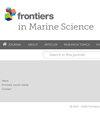南极罗斯海特拉诺瓦湾沿海地区上层混合层浮游植物分类组成、养分利用及生物地球化学
IF 3
2区 生物学
Q1 MARINE & FRESHWATER BIOLOGY
引用次数: 0
摘要
在 BioAPRoS 项目(罗斯海生物气溶胶和初级生产)范围内,在南极洲罗斯海意大利基地马里奥-祖切利站(Mario Zucchelli Station)前的 Terra Nova 海湾(TNB)沿海地区开展了两项研究活动,时间跨度分别为 2018 年 11 月 13 日至 2019 年 1 月 30 日(BioAPRoS18)和 2019 年 12 月 1 日至 2020 年 1 月 30 日(BioAPRoS19),在此期间该地区被归类为边缘冰区(MIZ)。目标是研究上混合层(UML)的营养动态、浮游植物生物量和分类组成,探索不同浮游植物群的同化偏好及其生物地球化学效应。研究结果与 1990 年代在同一地区开展的类似活动进行了比较。与之前的结果一致,UML 持久存在,并且始终很浅(5-18 米)。养分浓度从春季到夏季呈下降趋势,与 Chla 同步相反,这表明浮游植物生长期间养分消耗明显。在浮游植物夏季繁殖期间出现了差异;在 BioAPRoS18 中,由于ΔN/ΔP 去除率为 11.8,N/P 约为 40,这是已知的典型情况;而在 BioAPRoS19 中,N/P 为 6 左右,ΔN/ΔP 为 17.6,这是前所未有的情况。此外,Si/P 和 Chla/Si 比率也出现了差异。硅藻是两次活动中的主要群体,但它们的组成差异很大。在 BioAPRoS18 中,笔状硅藻,特别是卷曲硅藻(Fragilariopsis curta)与上世纪 90 年代一样普遍,而在 BioAPRoS19 中,中心硅藻,特别是 Dactyliosolen tenuijunctus 占主导地位,这在以前从未出现过。两种硅藻群在营养动态和分类组成上的这些差异,很可能表明氮和磷的同化方式不同,Dactyliosolen tenuijunctus 与 Fragilariopsis curta 不同,它更倾向于氮的同化,而不是磷的同化。TNB 是一个重要的海洋生态系统,其生物和生物地球化学特征在经历了自 20 世纪 90 年代以来的相对稳定后正在发生变化,这可能是当前气候变化的结果。有必要对这些趋势进行深入调查和监测,以便有效地理解和管理这些变化。本文章由计算机程序翻译,如有差异,请以英文原文为准。
Phytoplankton taxonomic composition, nutrients utilization and biogeochemistry in the upper mixed layer in the coastal area of the Terra Nova Bay, Ross Sea, Antarctica
Within BioAPRoS project (Biogenic Aerosol and Primary production in the Ross Sea) two research campaigns were conducted in the coastal area of Terra Nova Bay (TNB) in front of the Italian Base Mario Zucchelli Station, Ross Sea, Antarctica, spanning from 13/11/2018 to 30/01/2019 (BioAPRoS18), and from 01/12/2019 to 30/01/2020 (BioAPRoS19), an area classified as Marginal Ice Zone (MIZ) during this period. The goal was to study nutrient dynamics, phytoplankton biomass and taxonomic composition in the upper mixed layer (UML), exploring assimilation preferences of different phytoplankton assemblages and their biogeochemical effects. The findings were compared with similar 1990s campaigns in the same region. In line with the previous outcome, UML was persistent and always very shallow (5-18 m). Nutrient concentrations showed decreasing trends from spring to summer synchronously opposite to Chla , highlighting pronounced consumption of nutrients during phytoplankton growth. Discrepancies emerged during phytoplankton summer bloom; in BioAPRoS18 N/P was about 40 due to ΔN/ΔP removal ratio of 11.8, a typical already known condition, while BioAPRoS19 showed an unprecedented N/P around 6 with ΔN/ΔP of 17.6. Also, differences in Si/P and Chla /Si ratios emerged. Diatoms were the primary group in both campaigns, but they exhibited highly differentiated composition. In BioAPRoS18 pennate diatoms, notably Fragilariopsis curta , were prevalent as in ‘90s campaigns, while BioAPRoS19 experienced the dominance of centric diatoms, especially Dactyliosolen tenuijunctus , never occurred before. These differences in nutrients dynamics and taxonomic composition between the two diatom assemblages, most likely indicate different assimilation modalities of N and P, with Dactyliosolen tenuijunctus favouring N assimilation over P, unlike Fragilariopsis curta . Biological and biogeochemical characteristics of TNB, a pivotal marine ecosystem, are then displaying shifts after relative stability since the 1990s that could be the result of current climate change. These trends necessitate in-depth investigations and monitoring to comprehend and manage these shifts effectively.
求助全文
通过发布文献求助,成功后即可免费获取论文全文。
去求助
来源期刊

Frontiers in Marine Science
Agricultural and Biological Sciences-Aquatic Science
CiteScore
5.10
自引率
16.20%
发文量
2443
审稿时长
14 weeks
期刊介绍:
Frontiers in Marine Science publishes rigorously peer-reviewed research that advances our understanding of all aspects of the environment, biology, ecosystem functioning and human interactions with the oceans. Field Chief Editor Carlos M. Duarte at King Abdullah University of Science and Technology Thuwal is supported by an outstanding Editorial Board of international researchers. This multidisciplinary open-access journal is at the forefront of disseminating and communicating scientific knowledge and impactful discoveries to researchers, academics, policy makers and the public worldwide.
With the human population predicted to reach 9 billion people by 2050, it is clear that traditional land resources will not suffice to meet the demand for food or energy, required to support high-quality livelihoods. As a result, the oceans are emerging as a source of untapped assets, with new innovative industries, such as aquaculture, marine biotechnology, marine energy and deep-sea mining growing rapidly under a new era characterized by rapid growth of a blue, ocean-based economy. The sustainability of the blue economy is closely dependent on our knowledge about how to mitigate the impacts of the multiple pressures on the ocean ecosystem associated with the increased scale and diversification of industry operations in the ocean and global human pressures on the environment. Therefore, Frontiers in Marine Science particularly welcomes the communication of research outcomes addressing ocean-based solutions for the emerging challenges, including improved forecasting and observational capacities, understanding biodiversity and ecosystem problems, locally and globally, effective management strategies to maintain ocean health, and an improved capacity to sustainably derive resources from the oceans.
 求助内容:
求助内容: 应助结果提醒方式:
应助结果提醒方式:


